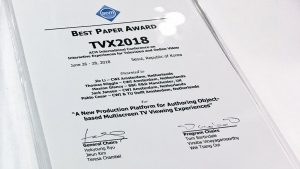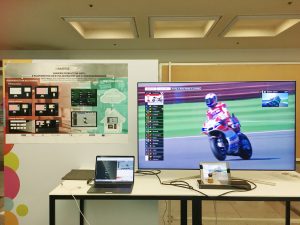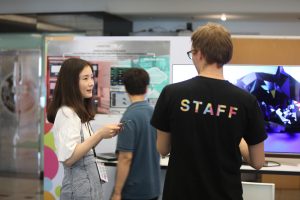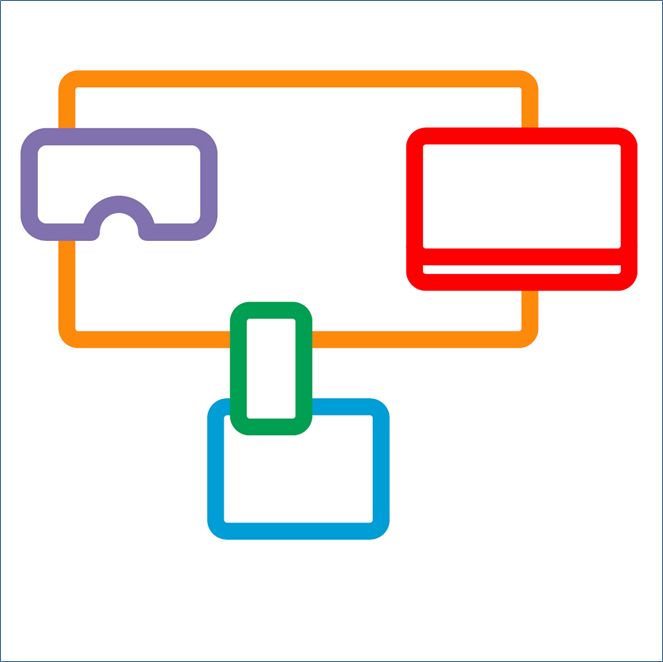Object-based media: the ‘next big thing’
“BT Sport: Object-based delivery ‘next big thing’ ” – so reads the title of a recent article on the web site Advanced Television. Doug Williams from BT argues that this illustrates that we are making progress on exploitation – although perhaps not in the way you might expect.
A key objective of an Innovation action like 2-IMMERSE is to be able to show that the project has an impact, and most particularly that it leads to commercial impact. Simplistically it would be nice to think 2-IMMERSE designed and proved the viability of a widget, and that following the project a new company was started that made, marketed and sold said widget. That would be an easy story to tell – but things don’t often work like that.
2-IMMERSE is a collaborative project involving, among others, BBC, BT, CISCO and IRT, and in this blog post I want to tell you a little about some of the progress we are making towards delivering our exploitation objectives. I am not telling the whole story, just relating something of what is happening in BT.
 As in the suggested ‘easy to tell’ story, 2-IMMERSE is designing and proving the viability of something, though that something is not a widget. We are proving, through the work done on the MotoGP experience and on the football trials, for example, that using the object–based delivery approach, we can create multi screen TV-based experiences and that those experiences can be appealing. We have worked closely with rights holders BT Sport and Dorna Sports as our experiments progressed and we have shared our progress with those rights holders along the way.
As in the suggested ‘easy to tell’ story, 2-IMMERSE is designing and proving the viability of something, though that something is not a widget. We are proving, through the work done on the MotoGP experience and on the football trials, for example, that using the object–based delivery approach, we can create multi screen TV-based experiences and that those experiences can be appealing. We have worked closely with rights holders BT Sport and Dorna Sports as our experiments progressed and we have shared our progress with those rights holders along the way.
A fundamental aspect of this project is that the delivery of the TV experiences is based on objects – where those objects can be video streams, graphics, audio streams or interactive elements that are assembled, according to rules, across the devices that are available to present the experience. There might be an element of “so what?” to that description. It does not highlight any benefits and gives no obvious reason why such an approach is useful to a broadcaster. But there is a simple benefit addressing something that is distinctly missing from current TV services — and that is the ability to personalise or customise the experience to better suit the context in which the TV experience is being consumed.
TV is great. I am writing this the morning after nearly half the UK population were together watching England play, and disappointingly lose, in the semi-final of the World Cup. Television is the only medium than can achieve such moments where such a large fraction of the population are all sharing the same experience. And that’s magic.
But.
• What if I was hard of hearing and wanted to quieten that crowd volume and increase the commentary volume so I could hear the commentary more clearly? I couldn’t do that last night, but I could with the object-based delivery approach.
• What if I was watching on a small TV and found the graphics a bit hard to read and wanted to increase the size of the graphics so I could read them more easily? I couldn’t do that last night, but I could do that with the object-based delivery approach.
• What if I was profoundly deaf and wanted to pull up a signed commentary on the TV screen? I couldn’t do that last night, but with the object-based delivery approach that is possible.
• What if I wanted to actively track the relative possession enjoyed by each of the teams throughout the game? I couldn’t do that last night, but I could do so with the object-based delivery approach.
• What if I was interested in seeing at all times, the expressions on each of the different managers’ faces? I couldn’t do that last night, but with the object-based delivery approach I could.
The object-based delivery approach provides ithe ability to personalise the TV experience to better address the needs of a large number of niche populations. Whether they are characterised by a need for more data, clearer graphics or a different audio mix. We’ve been discussing these options with our rights-holders partners for some time now, and together we are beginning to focus on these benefits and to work out how we could take them from the lab to the living room.
BT Sport have a fantastic innovation record. BT Sport were the first to do deliver live UHD TV in Europe. BT Sport were among the first to provide 360 video coverage of live sporting events. BT Sport were the first to use Dolby Atmos to deliver even more compelling soundscape to accompany the pictures. And now? Well now it’s good to see reports of Jamie Hindhaugh, COO of BT Sport, and the one who has driven innovation in the company, ruminating on what innovations are next in the pipeline.
have a fantastic innovation record. BT Sport were the first to do deliver live UHD TV in Europe. BT Sport were among the first to provide 360 video coverage of live sporting events. BT Sport were the first to use Dolby Atmos to deliver even more compelling soundscape to accompany the pictures. And now? Well now it’s good to see reports of Jamie Hindhaugh, COO of BT Sport, and the one who has driven innovation in the company, ruminating on what innovations are next in the pipeline.
According to an article penned by Colin Mann of the Advanced Television web site, reporting on the Love Broadcasting Summit,
[Jamie Hindhaugh] didn’t see VR and 3D as necessarily the future for sports viewing, as they lacked the social aspect, with BT preferring to offer such options as different camera angles, instead suggesting that object-based delivery would grow with the spread of IP. ‘We will start giving you objects, packages, templates, so you can create your own version of what you are watching.‘
Hindhaugh said that hardcore fans of MotoGP could benefit from additional graphics and stats available to the broadcaster. BT would curate the data, and allow the viewer to choose their preferences from the programme feed. ‘That’s where we’re going. That’s where the next big initiative is coming through, combined with 5G mobile.’
We have always seen our greatest potential for innovation impact in large companies as being the ability to affect the way they choose to develop their services. We have set out to work with the parts of our business that run key services and to effect innovative change. We are pleased to see the ideas we are developing and demonstrating are appealing not only to users but also to decision makers and that innovations developed in this project could be the ‘next big thing’.
READ MORESuccess for 2-Immerse at TVX
Jie Li honoured with Best Paper Award
 On 27 June Jie Li of the Distributed and Interactive Systems (DIS) group at 2-IMMERSE partner CWI was awarded with the Best Paper Award at ACM TVX 2018, the ACM International Conference on Interactive Experiences for Television and Online Video. Li won the award for the paper ‘A New Production Platform for Authoring Object-based Multiscreen TV Viewing Experiences’. Outlining research done within 2-IMMERSE, the paper has as co-authors Pablo Cesar, Maxine Glancy (BBC), Jack Jansen and Thomas Röggla
On 27 June Jie Li of the Distributed and Interactive Systems (DIS) group at 2-IMMERSE partner CWI was awarded with the Best Paper Award at ACM TVX 2018, the ACM International Conference on Interactive Experiences for Television and Online Video. Li won the award for the paper ‘A New Production Platform for Authoring Object-based Multiscreen TV Viewing Experiences’. Outlining research done within 2-IMMERSE, the paper has as co-authors Pablo Cesar, Maxine Glancy (BBC), Jack Jansen and Thomas Röggla

Multiscreen TV viewing refers to a spectrum of media productions that can be watched on TV screens and companion screens such as smartphones and tablets. TV production companies are now promoting an interactive and engaging way of viewing TV by offering tailored applications for TV programs.
However, viewers are demotivated to install dozens of applications and switch between them. This is one of the obstacles that hinder companion screen applications from reaching mass audiences. To solve this, TV production companies need a standard process for producing multiscreen content, allowing viewers to follow all kinds of programs in one single application. This paper proposes a new object-based production platform for authoring and broadcasting programs for multiscreen.
 Besides the awarded paper, the DIS group also presented a demo at the conference, showcasing object-based live broadcasting of a sports event, to both a large TV screen and companion screens. The demo included both the producer and the user side. The producer side takes place inside an outside broadcast truck, where the director/producer can insert on-demand snippets and interactive components in the live broadcast. The user side is a home, where a viewer with a TV screen and several companion devices enjoy a personalized and interactive experience.
Besides the awarded paper, the DIS group also presented a demo at the conference, showcasing object-based live broadcasting of a sports event, to both a large TV screen and companion screens. The demo included both the producer and the user side. The producer side takes place inside an outside broadcast truck, where the director/producer can insert on-demand snippets and interactive components in the live broadcast. The user side is a home, where a viewer with a TV screen and several companion devices enjoy a personalized and interactive experience.

CWI’s Distributed and Interactive Systems (DIS) research group focuses on facilitating and improving the way people access media and communicate with others and with the environment. They address key problems for society and science, resulting from the dense connectivity of content, people, and devices. The group uses recognized scientific methods, following a full-stack, experimental, and human-centered approach.
More at TVX from BBC and IRT
A work-in-progress paper submitted by BBC and IRT explores the potential of augmented reality technology as a novel way to allow users to view a sign language interpreter through an optical head-mounted display while watching a TV programme. We address the potential of augmented reality for personalisation of TV access services. Based on guidelines of regulatory authorities and research on traditional sign language services on TV, as well as feedback from experts, we justify two design proposals. We describe how we produced the content for the AR prototype applications and what we have learned during the process. Finally, we develop questions for our upcoming user studies.
Also at TVX BBC and IRT demonstrated results of our work stream which targets deploying the 2-IMMERSE apps on HbbTV 2.0 devices. In cooperation with Samsung we showed the 2-IMMERSE MotoGP experience from Silverstone GP 2017 on a recent consumer device running an HbbTV 2.0 ready firmware.
READ MORE

